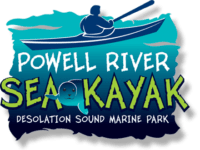[This is the second and final instalment of a series written by PRSK guide Luke Raftl. Read the first Part of the series here]
Day 4
After 3 days on the move and paddling around 40 nautical miles, the middle day of our adventure was a rest day of sorts. Using the Toba Inlet camp as a base for a whole day, we woke and ate breakfast without the usual hustle, and launched without having to pull down our tents just after 10am.
Our destination was deeper into Toba Inlet, with no set itinerary or plans other than to experience the thrill of paddling into the mountains. Huge granite cliffs plunged on both sides straight into the turquoise waters of the fjord, and every corner we turned gave us a new perspective of the rugged Coast Mountains we had come to explore.
Already, as early as it was, we could feel the first breath of wind being pulled into the inlet by the rising temperatures of the day. These sea breezes – or anabatic winds – are prevalent amongst the coastal inlets of British Columbia. With the warm air over the mountains rising in the heat and being replaced by the cooler ocean air from the west, these winds can easily reach over 25 knots on an otherwise calm day and create wind waves in Toba of over 6 feet!
While for now it was still just a nice breeze at our back, we paddled along the steep cliffs and came underneath a cascading waterfall that dropped from a glacial lake many hundreds of metres above – not quite as thunderous as it would have been in May, still a impressive sight in the mid-summer heat. After paddling a little further into the inlet and taking pictures underneath the silent and majestic peaks, we turned back a with a small pang of regret and made our way back to camp into the building wind.
Using the varied shoreline as cover to get out of the gusts as they funnelled up the centre of the inlet, we comfortably returned to camp in time for a late lunch and some relaxing swimming and reading on the beach, content in the knowledge that more good days of paddling remained on the loop home.
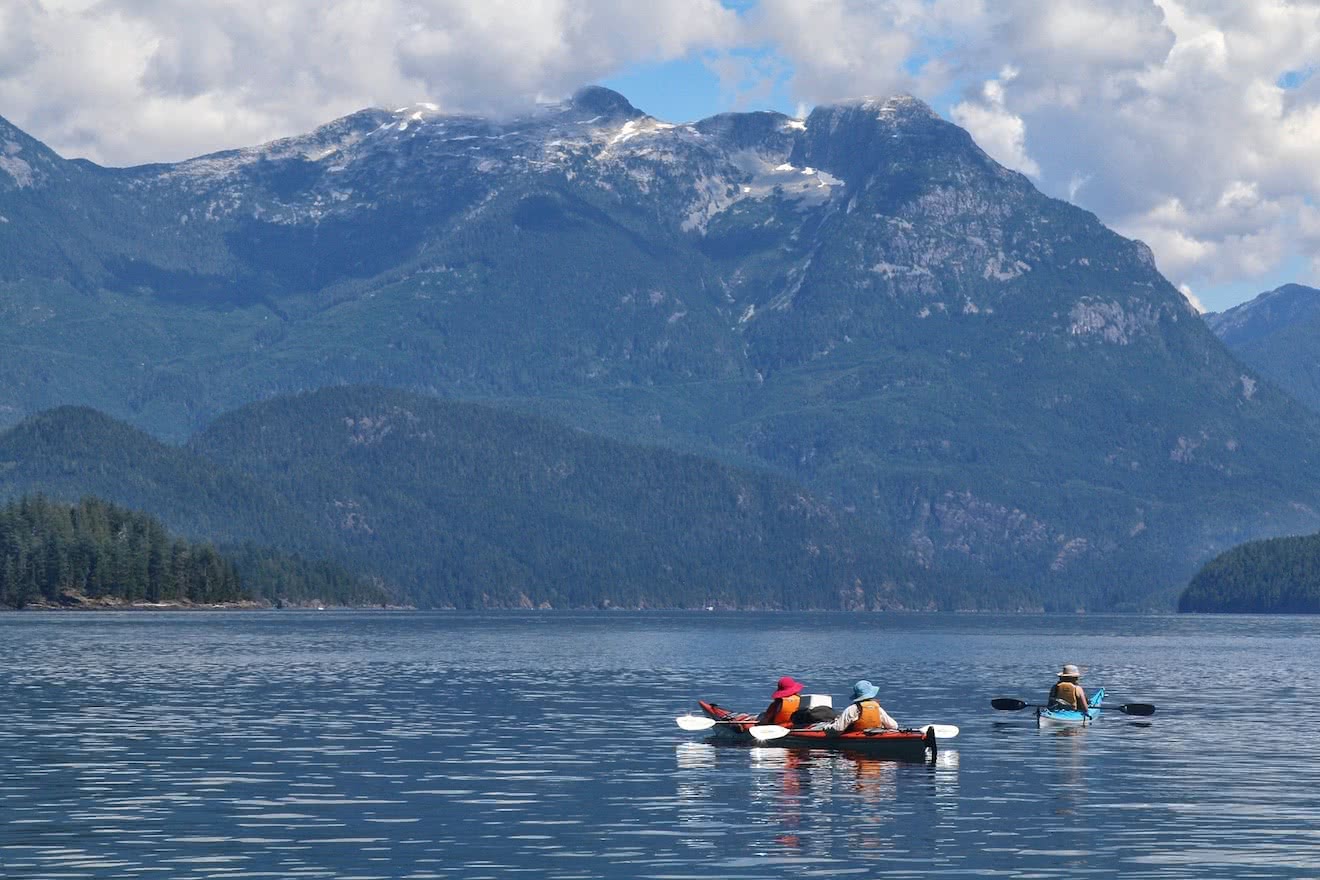
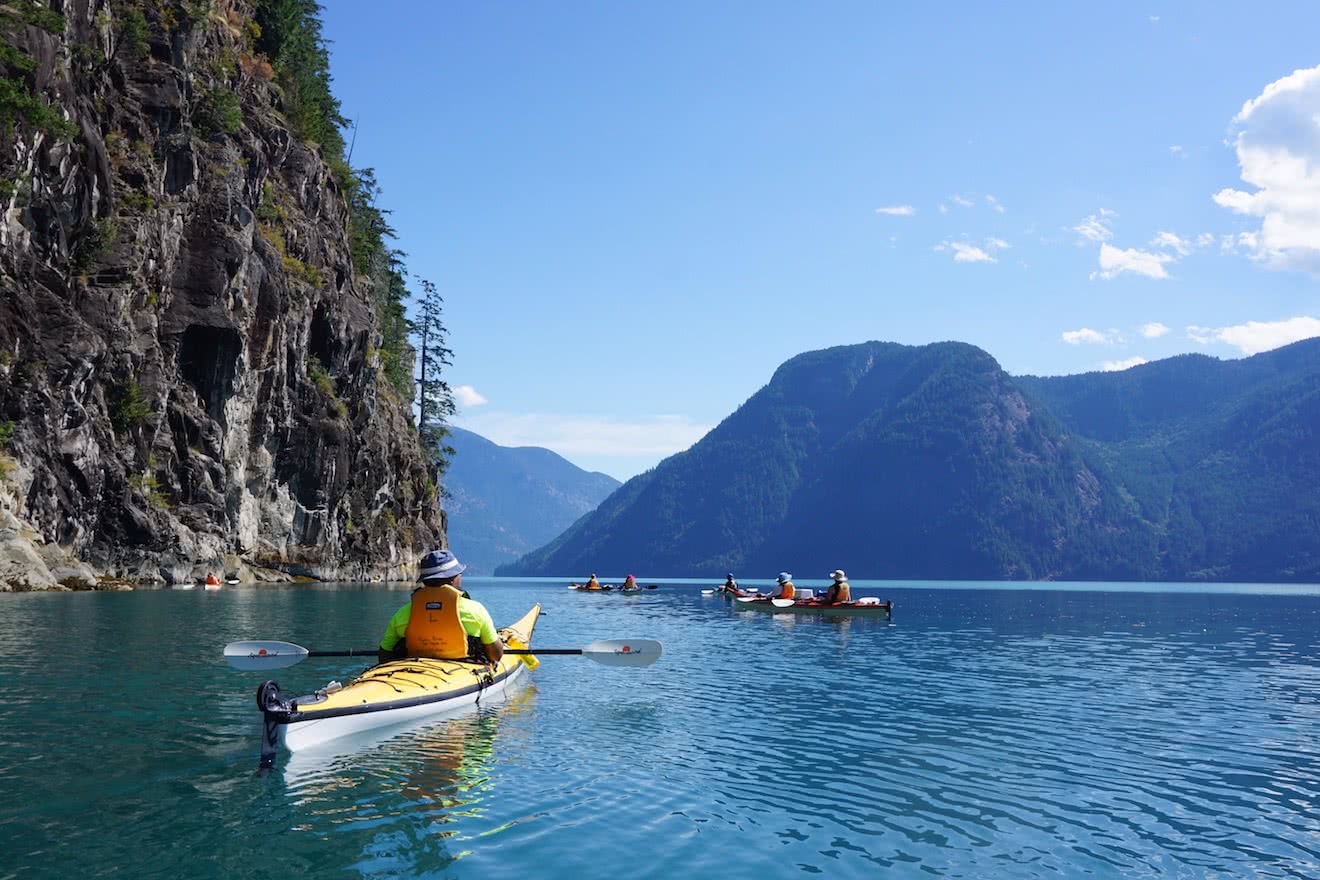
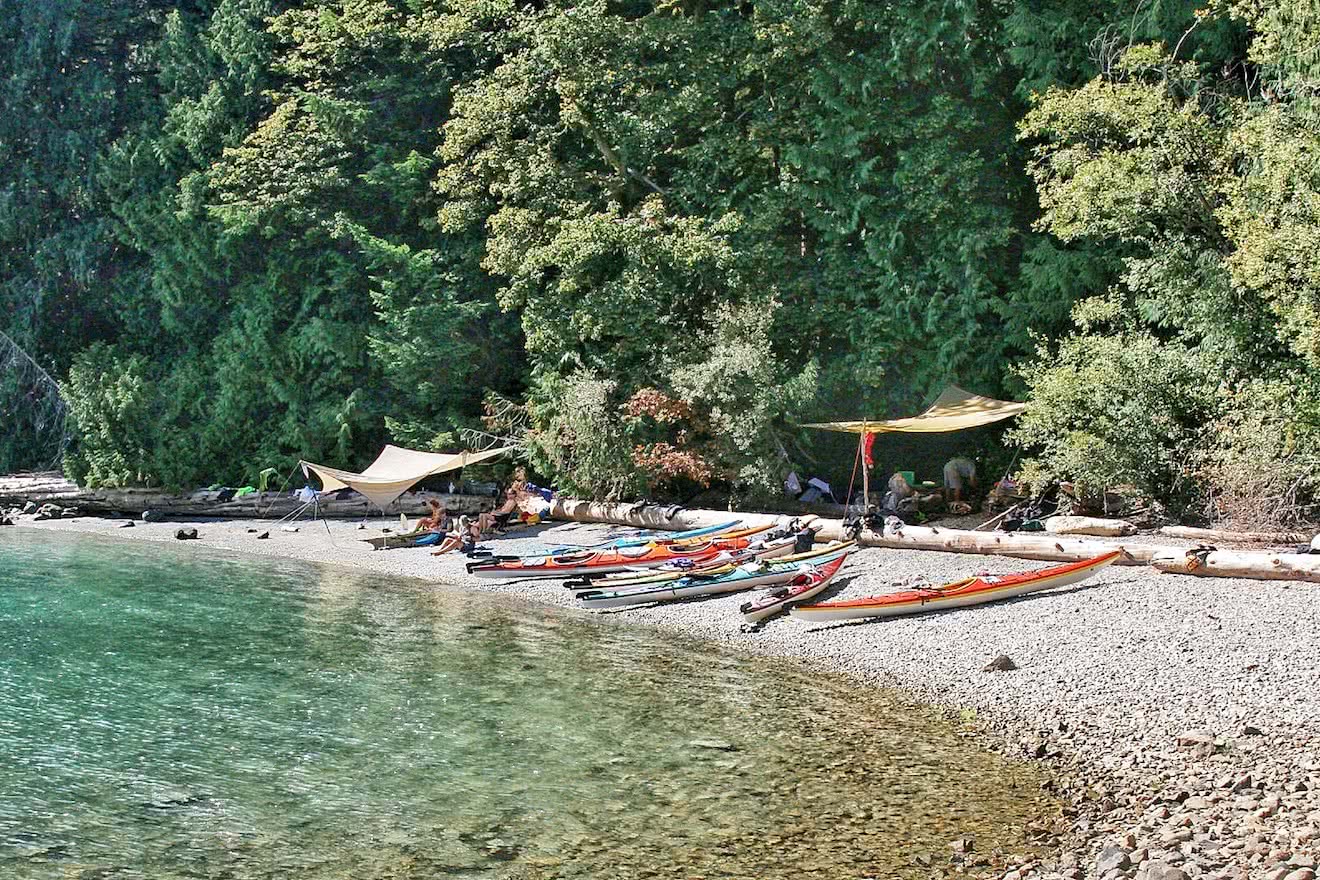
Day 5
We were on the move again on day 5, crossing the mouth of Toba Inlet just after 10am and entering Homfray Channel for our long return journey to Desolation Sound. One guest was overheard over breakfast lamenting that the mountain scenery was all behind them starting from today, and Kyle and I smiled in the knowledge that there were still many breathtaking mountain vistas to come on another perfectly clear and warm day.
We were making great time as we entered Homfray from the north. Our guests were by now supremely confident and comfortable paddling for extended periods with efficient strokes that they could continue all day long. There wasn’t a ripple on the water, our only enemy was the beating sun, that we know would increase in intensity as the day went on.
We paddled past Atwood Bay on the mainland side of the channel in serene conditions, idly chatting away and enjoying the mountain views. Iconic Mount Denman looked much different but no less spectacular from this direction, rising jaggedly above our heads.
Suddenly Kris, one of our guests, stopped mid conversation and stared into the distance.
“I’m not sure, but I think I just saw…”
“Wooooooaaaaaahhhhhh”
We all exclaimed in disbelief as a massive humpback whale came up in the distance, its entire body almost leaving the water and becoming airborne down towards the mouth of Homfray Creek in front of us.
We came together and waited, seconds ticking slowly and breathlessly by.
And then again, on more time, the giant repeated its breach after what seemed like an eternity, but was probably only 15 seconds, as we waited and held our breath.
We all whooped and hollered and the whale – or whales, as we could now see that there were two of them – began moving in front of our path towards the middle of the channel.
For 25 minutes the group sat together, rafted up in silence, taking photos and watching the slow drift of the whales north as they came up together for air, one by one, over and again, before they were long out of sight, and we returned to the paddle ahead.
We had lunch in a nice bay at Homfray Creek, and then jumped back in the kayaks and continued south past Homfray Lodge. High up on the rocks just north of the lodge you can spy old pictographs created in a time long past, and we sat and admired them and tried to interpret their meanings amongst ourselves.
On our left we paddled beyond Forbes Bay and Forbes Creek, directly below Mount Denman itself. The day was getting on and the sun was hot in the sky, and we could feel the energy of the group slowly seeping away.
“Just a little further”, we urged. “Not long now, a couple more bays ahead.”
Finally we reached our goal: a beautiful campsite that looked both north up Homfray Channel to the mountains had left, and west down beyond Desolation Sound again to the rugged spine of Vancouver Island far beyond. It was a wonderful point of land shimmering in the golden afternoon light, and our guests took to the water and swam in the warm ocean temperatures as Kyle and I prepared dinner and appetizers under an incredible Maple tree that reached it’s arm like branches out and over the sea.
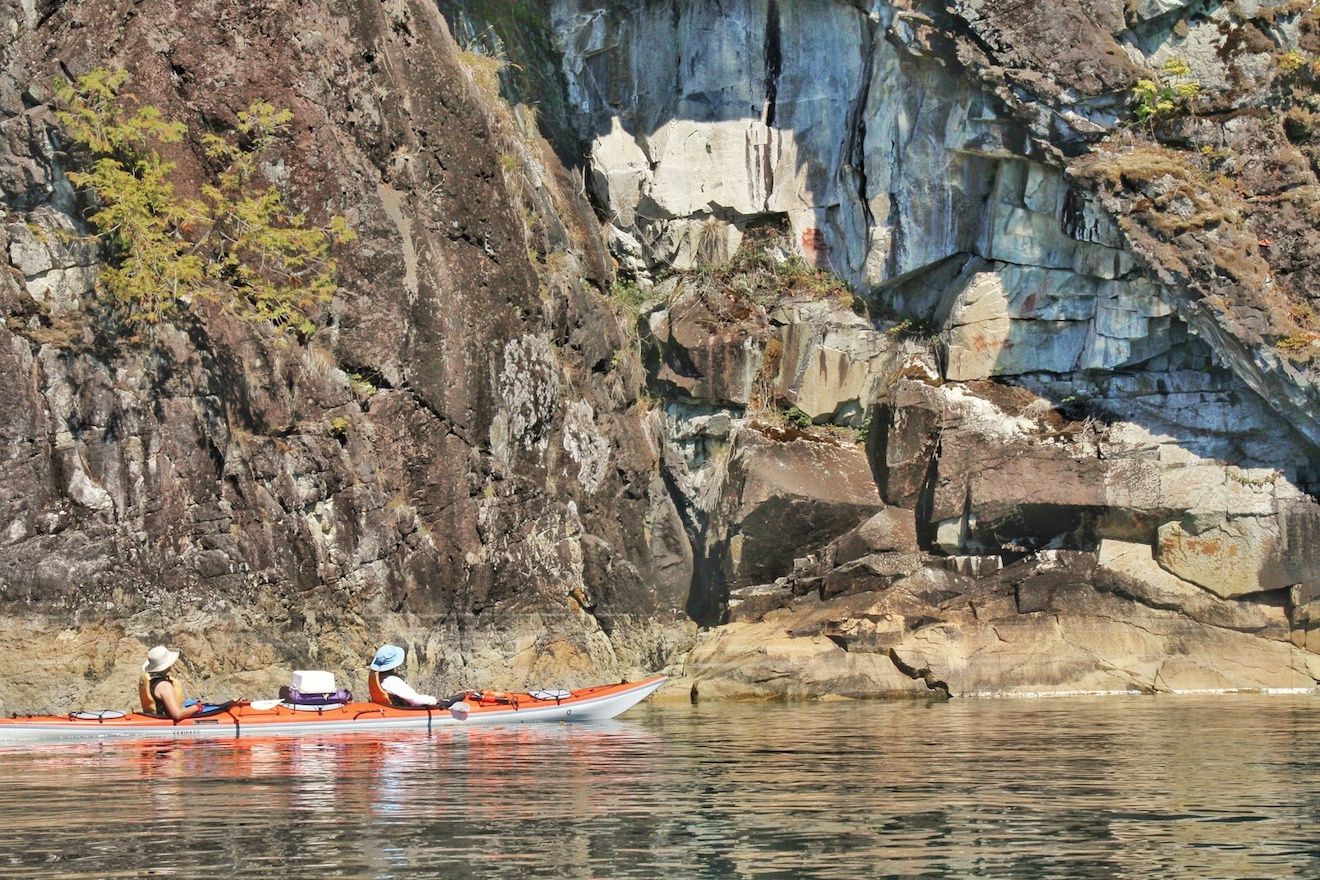
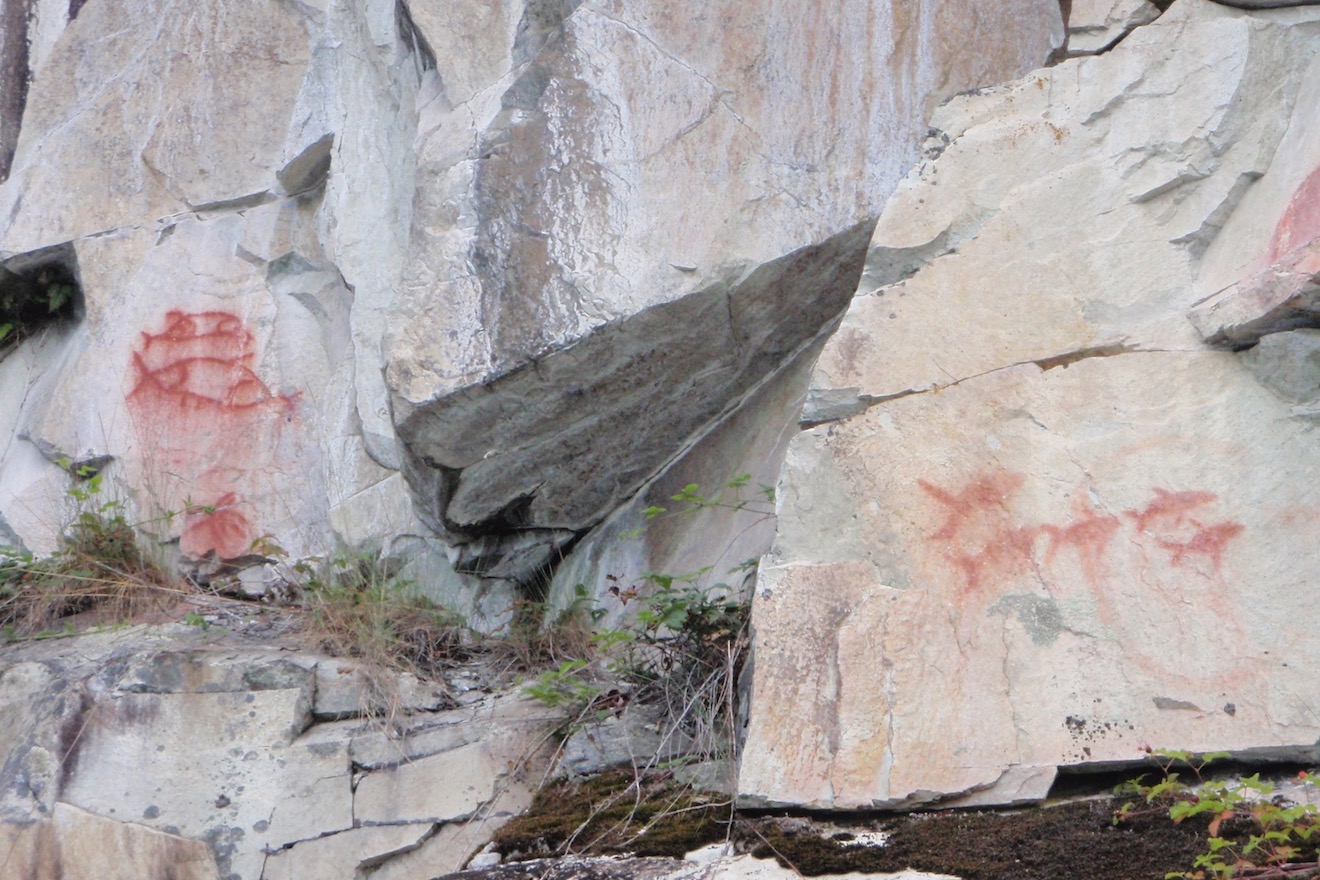
Day 6
The day dawned hot and bright again, and we prepared for our return to Desolation Sound.
We had planned the Mountains Tour to avoid Desolation during the August long weekend, and now hoped to return to the Sound at the tail end of the busiest weekend of the year and avoid most of the crowds.
We paddled south along the final mainland potion of Homfray Channel. As we came upon Prideaux Haven – an area renowned as a busy and popular anchorage for sailors and yachts – we could see a number of boats coming and going from the sheltered cove. Passing by along the northern edge of the anchorage, we avoided the traffic jam and then cut in amongst the islands and bays on Prodeaux haven’s western edge, before deciding to continue on and land on the idyllic Curme Islands before lunch, thus giving us all an extended afternoon of rest and relaxation after some long and rewarding days on the water.
The Curmes are popular with kayakers, especially in August, but we arrived early enough in the day to claim the entire southern Curme Isle for ourselves. As the afternoon dragged into evening and the sun began to set in hues of orange and yellow and red over Mink Island to the west, there was plenty of swimming and even some self-rescue practice by some of our more committed guests!
Finally the day ended and we all started to head to our tents, only for another cry to be heard in the night.
“Who wants to see the phosphorescence?!”
Kyle had gone down to clean one last dirty dish in the dark and had discovered that the magical, glowing lights of bioluminescent plankton were dancing beneath the surface of the water. We lingered for half an hour or more as sticks and rocks and eventually a few brave guests went into the water and swam amongst the glowing lights, before we all eventually made our way to our tents for the final time on this grand adventure.
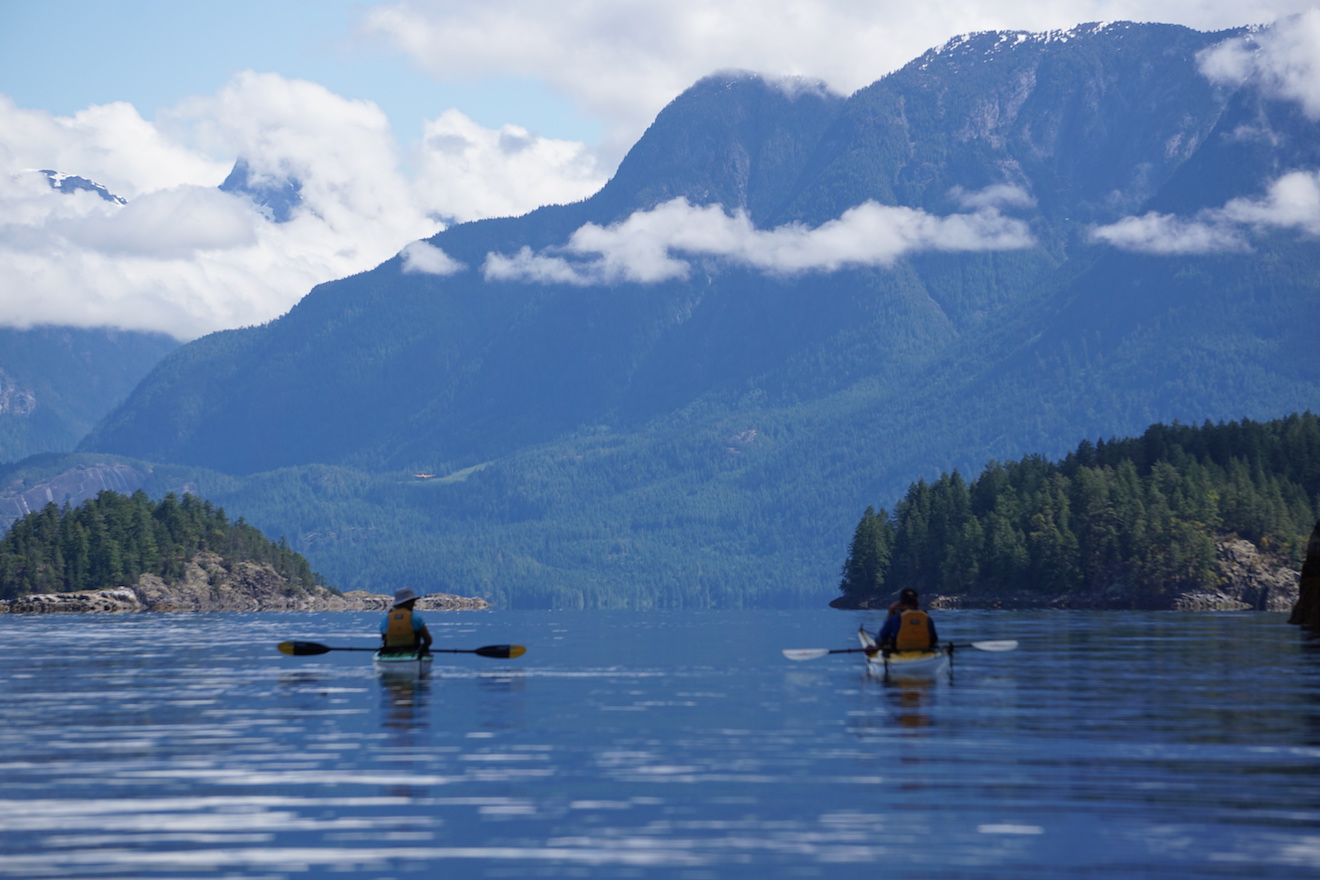
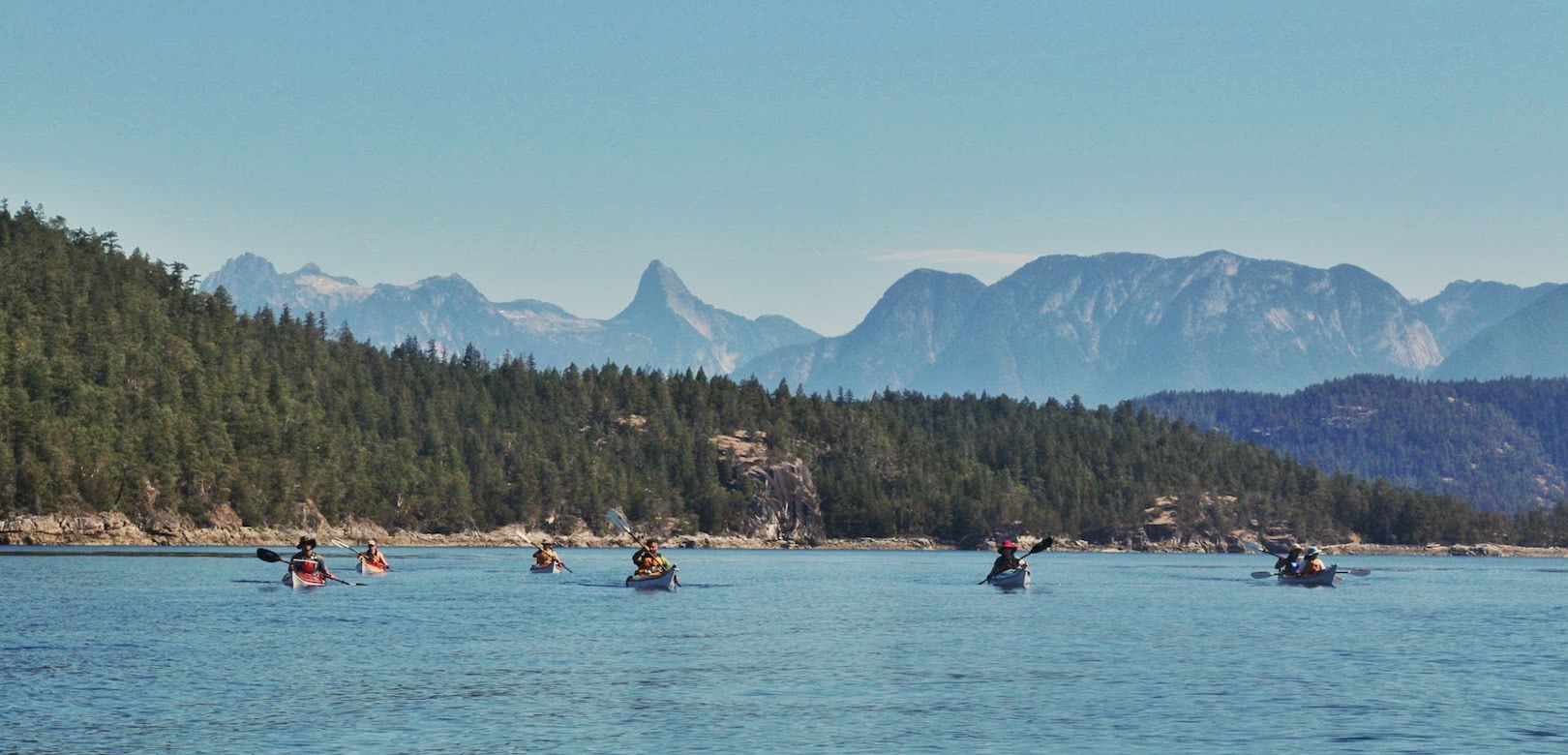
Day 7
We didn’t rush on our final morning, and after getting on the water just after 10.30am we crossed in more perfect conditions to the south shore of Mink Island and paddled all the way to the western point, before crossing back into Malaspina Inlet and the final stretch towards home.
The current was rushing into the inlet as we approached, and we relaxed and let the surge of inflowing water carry us almost effortlessly towards our lunch spot in Grace Harbour. After one final meal together upon the bluffs overlooking Okeover Inlet to the south, we silently made our way to Penrose Bay and our launch site, vaguely recognizing the sites we had seen on the first morning of the trip a week ago.
Civilization returned as we closed in on home: first vacation homes on the inlet, then the sight of kayakers looming up in front of us and leaving Okeover for the start of their own journey into Desolation Sound, and then finally we turned the corner and entered Penrose Bay and our destination was in sight.
Friendly staff from PRSK came down to hail us and help us with our kayaks and gear, and in no time we were all standing on the shore and packing our vehicles and saying our goodbyes.
After being threatened with storms of wind and rain in the lead-up to the tour, this turned out to be some of the best paddling weather we experienced all summer in Desolation Sound! With a group of committed guests – with fantastic attitudes – that were all eager to learn and experience this special area of the BC mainland coast, this 7-day Mountains Tour was a highlight of the season for us here at Powell River Sea Kayak.
For more information about out 5- and 7-day kayak expeditions, please click through to our Expeditions page on this website!
[This is Part 1 of a 2 Part Trip Review Series written by a Powell River Sea Kayak guide — read the second part here]
On the August long weekend last year, seven intrepid guests and two guides from Powell River Sea Kayak took the opportunity that the fantastic weather presented us and paddled beyond Desolation Sound.
Over the course of a week we paddled in awe of immense mountains, beneath plunging waterfalls, and in the presence of majestic humpbacks. Our campsites were remote and beautiful, far off the beaten trail and laid out under a sheet of stars.
If you are interested in how an expedition-style tour with Powell River Sea Kayak plays out: from how much paddling occurs to the places you may visit to the things you can see, please read on!
Day One
The morning was grey, but the clouds were beginning to part as we launched from our home base in calm and protected Okeover Inlet on the first morning of our adventure.
The long-term weather report leading up to the trip was decidedly winter-like for the BC coast … but about 36 hours before guests arrived there was a sudden change, and the rain and wind forecast was instantly replaced with sun and warmth. In reality the seven days that we paddled into the mountains and back again saw probably the most perfect weather of the entire summer!
Our group consisted of 3 siblings and 2 spouses from Toronto, Ontario, as well as 2 friends from the west coast of BC that had completed one previous kayaking tour on Vancouver Island many years prior. Kyle and I – guides for this exciting expedition-style trip into the waterways of Pryce Channel and Toba Inlet north of Desolation Sound, rounded out the party.
We launched in the late afternoon and paddled with a slight tail wind north towards the mouth of Malaspina Inlet and the entrance to Desolation Sound. Passing our usual lunch spot in good time, we continued on and entered the Sound on the western side of the inlet and stopped for lunch after 2.5 hours of paddling at Feather Cove at the tip of Malaspina Peninsula.
After lunch we made two crossings, first to Kinghorn Island (the site of Cabana Desolation Eco Resort and beyond that a campsite that we often stay on the first evening of a tour), and then once more crossed to the Martin Islands in the northern part of Desolation Sound, a total of 9.5 nautical miles.
Desolation Sound is a key part of this tour – and we spent two nights here, the first and the last – but we were all looking north at what was to come in the coming days. After a wild salmon and risotto dinner everyone was slightly sore but very content as they went to bed just after the sun set over Cortes Island.
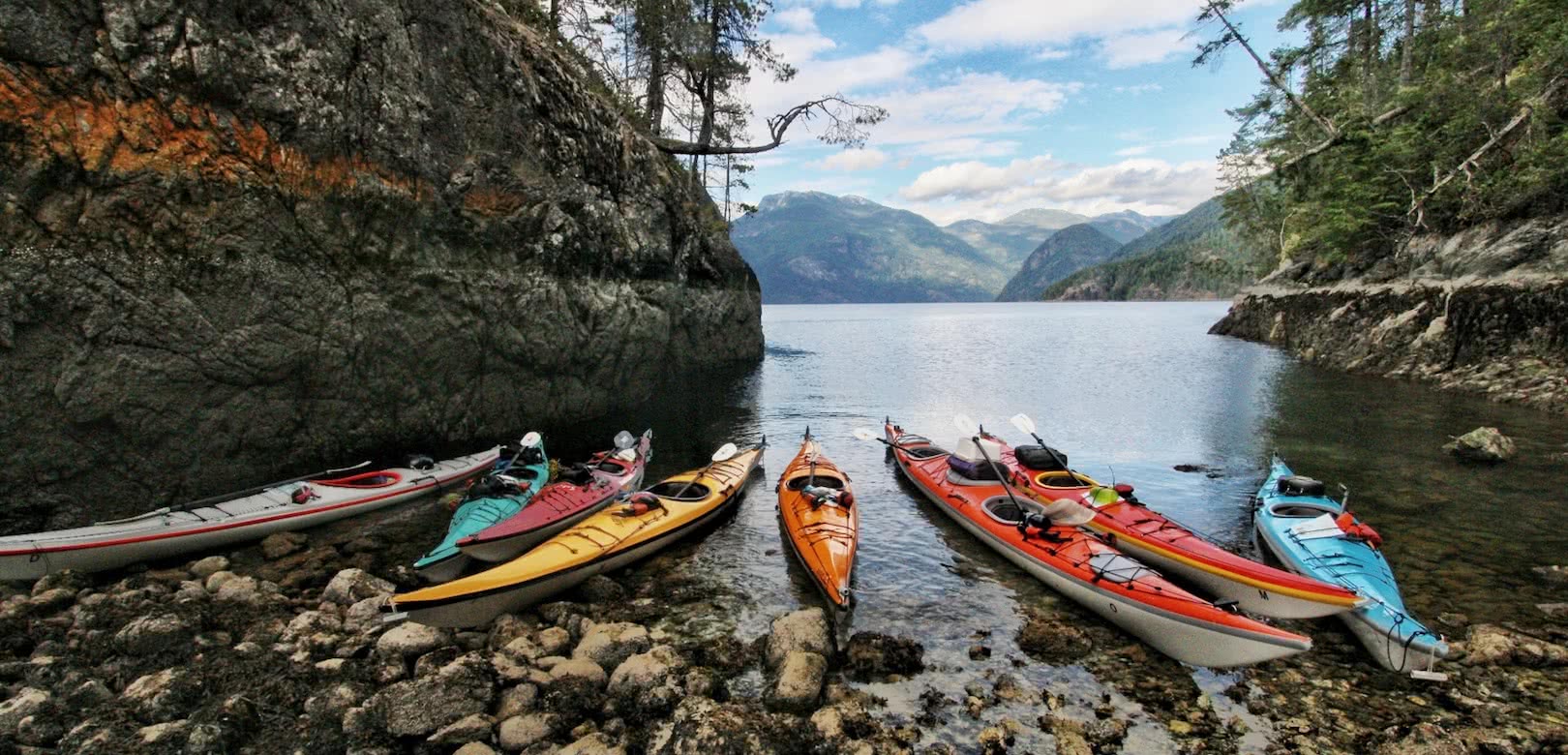
Day Two
We woke to the clear skies that came to dominate the rest of our adventure. A breakfast of scrambled eggs, sourdough toast and vegetable hash fuelled us up for the day ahead – the longest planned for the whole trip, from the Martin Islands north through Lewis Channel, beyond Teakerne Arm and Redonda Bay to a private tenured campsite just south of Connis Point at the tip of West Redonda Island.
The wind was light but variable as we paddled past Refuge Cove and attempted to settle into a rhythm for the day. Perhaps the muscles were a little stiff – and maybe the current was not in our favour – but the first leg of the day required everyone to dig a little deeper than yesterday as we approached the mouth of Teakerne Arm. Kyle and I traded places throughout the morning to check in on everyone and see how they were feeling. We continued to hone in on our guest’s strokes, striving to help them achieve greater efficiency that would come in incredibly helpful over the rest of the tour. After a brief discussion, we decided to stop for lunch a little earlier than originally intended to give everyone a nice break and rest before the afternoon push to camp.
After a quick switch of kayaks to give those of us feeling a little weary a chance to paddle together in a double, we launched again and headed north beyond Teakerne Arm. Conditions now were perfect – a slight tail wind and an ebb current that pulled us northwards.
Any time lost in the morning was quickly regained, yet as this was the day of our longest paddle, we still had a ways to go! As we reached Redonda Bay and the north-west tip of West Redonda Island, the mountains we had been searching for started to impose themselves on the scenery, and we stopped for a quick break one last time before our last push to camp directly opposite the impressive mass of Raza Island and the beginnings of the Coast Mountains to our north.
Not too many people camp this far north of Desolation Sound, and Kyle and I immediately set about creating a makeshift kitchen from whatever scanty pieces of driftwood we could find while our guests set themselves up with their tents and poured themselves a well-earned glass of wine.
Dinner tonight was Thai chicken and tofu lettuce wraps with hot coconut fried bananas for dessert – not bad fare for the remote environment! And to top it off, just as we sat on the cliff at the edge of camp to enjoy our meal, a humpback whale surfaced directly in front of our vantage point – less than 100 feet from our camp – and took 3 or 4 breaths in succession before diving deep into the channel on its way south. The perfect end to a long but incredibly rewarding day!
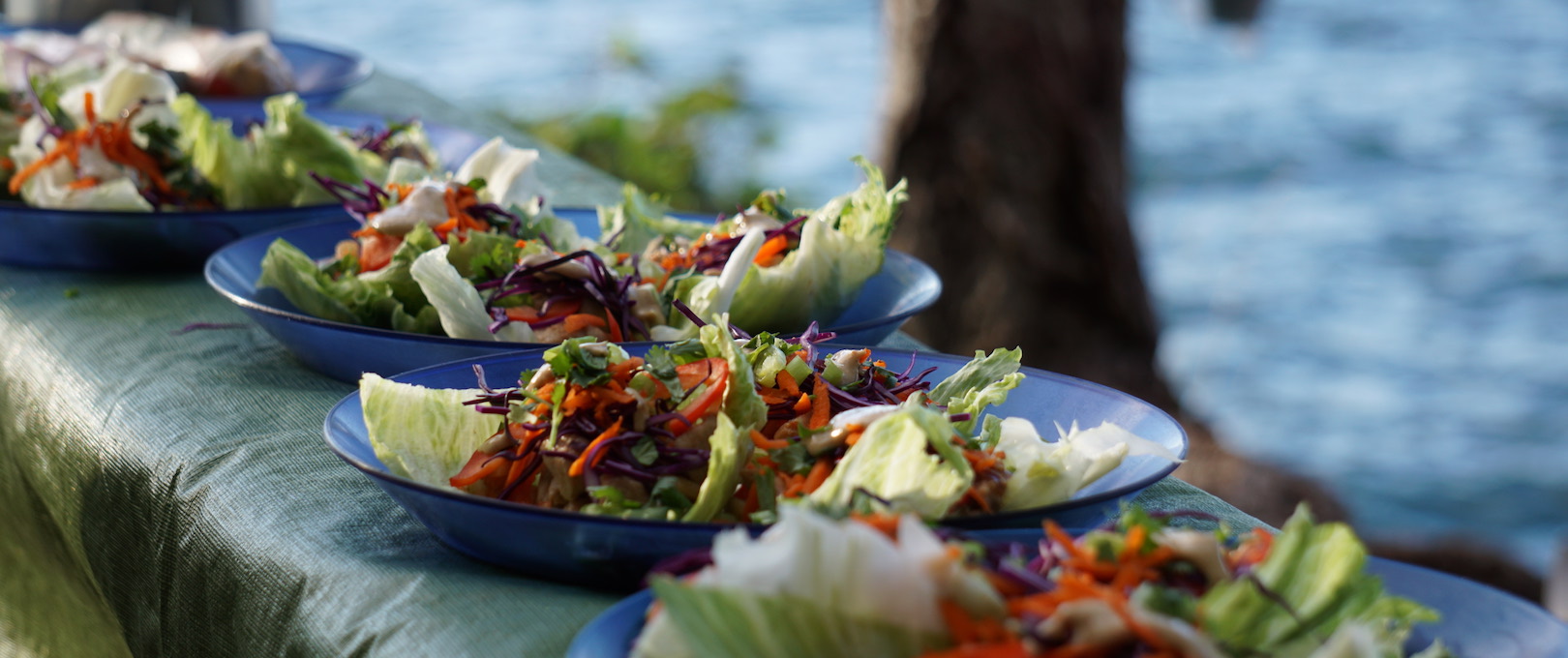
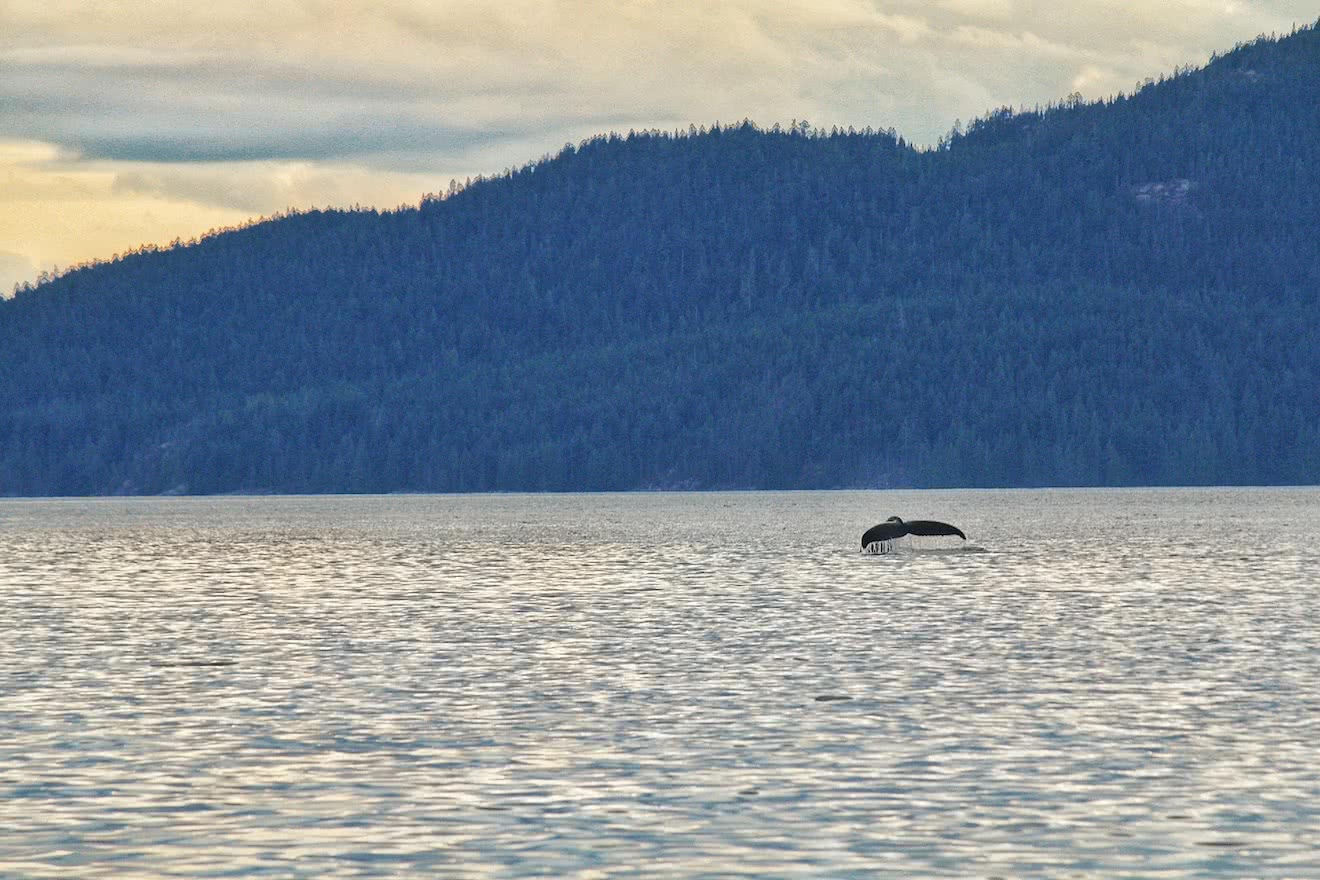
Day Three
The sun was peering over the rugged spine of West Redonda Island early on Day 3, illuminating the forest on Raza Island to the west and bathing the mountains to the north in brilliant light. We were all up early, devouring another delicious breakfast – butternut squash & leek pancakes today – before we hit the water as a group just as the sunlight reached over the towering trees behind our campsite and landed on our departing kayaks.
The water north of the Redonda Islands takes on a greenish hue, which shifts into tones of turquoise and blue as you turn to the east and paddle closer to the mouth of Toba Inlet. This is due to the glacial runoff that enters the sea from two rivers right at the head of Toba, and it conjures a feeling of more tropical environments than the temperate rainforests of the Pacific North West.
In fact, the entire terrain north of West Redonda Island feels more like the Hawaiian Islands or the coast of Thailand than anywhere else on the west coast. The lush green rainforest on both sides of Pryce Channel, where we were now paddling, drop precipitously straight into the greens and blues of the ocean, and water cascades down narrow ravines carved into the rugged island and mainland landscapes from lakes far above.
Ahead of us, to the east, we could see the first of the snow capped peaks that frame magnificent Toba Inlet, our destination for the day. With every stroke we approached closer, and once again a slight wind appeared at our back – this one caused by the inflow of cooler, ocean air rushing in to replace the warmer air above the sun-drenched mountains – which pushed us ever nearer still.
We crossed Pryce Channel after half an hour or so and were now paddling along the mainland coast. Perhaps one or two sailboats were spotted all morning, far in the distance, and it felt as though we were alone in this remote and awe-inspiring environment.
We rounded a point in the mainland and came upon a simply perfect beach of crushed rock and sand right at the mouth of Toba Inlet for lunch. From here the great, steep fjord twisted and turned its path right into the icy peaks of the Coast Mountains, which we could appreciate from our comfortable position in the sunshine thousands of feet below.
Our guests all went swimming in the blue ocean to cool down as Kyle and I prepared the lunch. Two and a half days of kayaking had turned everyone into efficient paddling machines, and while we were grateful for our idyllic lunch spot, everyone was just as eager to get back on the water and travel deeper into the mountains.
Our afternoon paddle along the north-western shore of Toba was in perfect, calm conditions and almost complete seclusion (with the exception of one solo kayaker that approached us from the south-east to ask for some campsite information, and then paddled alone back in the direction from which we came!)
Our campsite in Toba Inlet is another private tenure that we maintain for the exclusive use of our tour groups, and the perfect place to base ourselves for further exploration of this remote and impressive destination deep amongst the BC Coast Mountain range.
Our plan was to do just this – spend two nights at our comfortable base and paddle deeper into the inlet on Day 4, before resume our loop of the Redonda Islands and returning to Desolation Sound in the days to follow.
Our camp was another perfect beach of crushed rock and sand that received most of the day’s sun, with multiple tent spots hidden just beyond the trees in the cool shade of the forest behind us. Kyle and I set up our kitchen away from the tents – this is bear country after all – and set about creating another rich and fulfilling meal of Pasta with Pesto, Artichokes, Sun-dried Tomatoes and Black Olives, before the sun set over the mountains that now lay to our west and we all climbed into our tents in anticipation of exploring Toba Inlet in the morning.

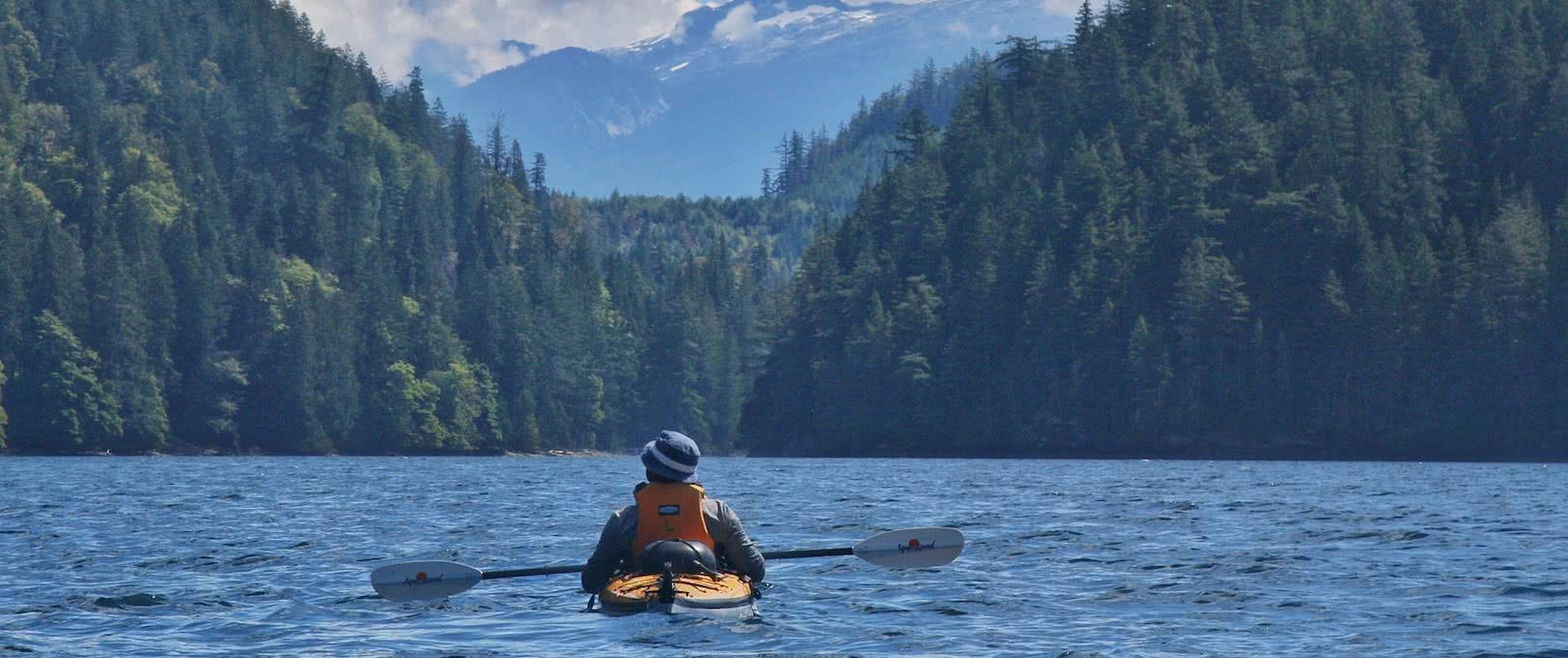
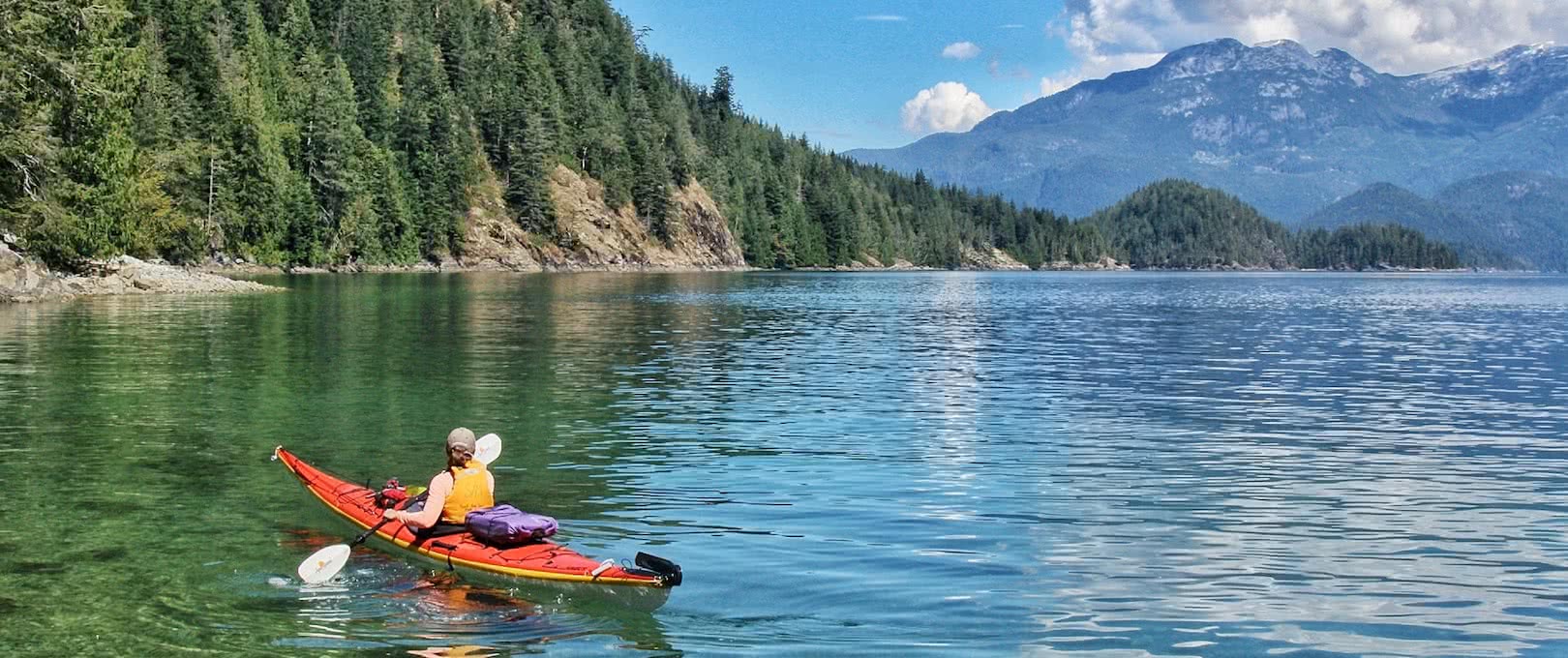
Desolation Sound is world famous for it’s remarkably warm ocean temperatures, which routinely reach 22 degrees celsius (74 degrees Fahrenheit) during those long, hot summer days of July and August.
As great as cooling off in the ocean can be, however, we know that nothing quite beats a freshwater soak in a warm, clean lake to wash away the salt of a mid-summer multi-day kayaking adventure.
Check out these incredible freshwater lakes easily accessible from Desolation Sound, perfect for a quick dip or an entire day or rest and relaxation.
Unwin Lake
This one is famous – accessed from the pullout in Tenedos Bay, a mere 45 minute paddle from the Curme Islands – Unwin Lake is a popular and attractive day trip paddle from your base camp in the heart of Desolation Sound.
From the campsite in Tenedos Bay, follow the trail for 10 minutes through an ancient temperate rainforest amongst humongous trees, and then choose your path to the left or the right hand side of the lake and find yourself a secluded corner to eat a lazy lunch, swim in the sun, or jump from a shoreline cliff into the warm water below.
The trail from the bay to the lake itself is a wonderful experience, with a number of side paths that snake away from the main trail and bring you to the base of an ancient old-growth cedar or a secret corner alongside a babbling waterfall flowing from the lake into the bay below.
Camping nearby include the Curme Islands, Tends Bay itself, as well as Bold Head at the entrance to Tenedos Bay – all of which are located within Desolation Sound Marine park and include tent platforms, pit toilets, and basic backcountry kitchen and picnic areas.
Black Lake
Another centrally located lake, Black Lake is found at the head of Roscoe Bay on the south eastern corner of West Redonda Island, about 90 minutes paddle from the Curme Islands to the south.
Roscoe Bay itself is a beautiful, narrow fjord that is a popular anchorage in the summer months with sailboats and small yachts. At the head of the Bay is an easy landing at a small campsite with an obvious trail beside a rushing creek to the lake. The trail arcs off to the right hand side once you reach the lake, and splits off in a number of places to reveal secluded places for groups or couples to find some privacy and relax along the shoreline.
Black Lake is probably the warmest of the lakes in Desolation Sound, and another perfect day paddle from a base camp on the Curme Islands. A short portage with empty kayaks is also possible along the flat trail, opening up even more potential exploration and adventure!
Wednesday Lake
Little known to kayakers, but well known to summer hikers of the Sunshine Coast Trail, Wednesday Lake can be accessed via a 30 minute hike from Cochrane Bay in Malaspina Inlet, about 2 hours paddle north of our launch site in Penrose Bay.
Paddle into the small pullout in Cochrane Bay and follow the trail to where it intersects with the marked Sunshine Coast Trail, where you can take a left turn and follow the trail in a southerly direction up and down for half an hour to reach the lake – perfect for a refreshing swim after some physical activity!
Wednesday Lake is warm, clear, and remote – meaning that you will very likely have the entire place to yourselves while you are there, with the possible exception of the occasional through hiker on the trail.
The lake is most easily accessed as a day trip from the campsites at Grace Harbour or Hare Point, about 30 or 40 minutes paddle from each, and is often used by kayakers as a great way to stretch the legs and embrace a different form of exercise during a sea kayak expedition in Desolation Sound.
Desolation Sound is a coastal BC summer paradise … yet while many paradise seekers aim to explore this area in July and August to maximize their chances of perfect weather, there are endless reasons that a June – or even May – Desolation Sound escape can be just as rewarding.
Here are six of our favourites:
1. Off-Peak Rates!
Whether you are joining a multi-day camping tour or spending a weekend at Cabana Desolation Eco resort, if you are kayaking with us before June 25th you stand to receive some juicy discounts.
Our Off-Peak Group rates are our best rates, and you only need a group of 4 to receive this discount during these Off-Peak times. That means savings of up to $150 per person for camping tours and up to $330 per person for Cabana Desolation packages!
Renters can also save money by kayaking earlier in the season, but please note the off-peak cut-off date for renting kayaks and equipment is May 15th.
2. Pleasantly Comfortable Temperatures
While hot summer days are perfect for swimming and snorkelling in Desolation Sound’s warm ocean waters, paddling in the heat of summer can be a brutal exercise.
June days are typically a little cooler than July and August on the coast – around 4 degrees on average – or the difference between a comfortable day of activity outdoors and a gruelling sweat in the heat!
3. A Truly Peaceful Holiday
From avoiding jostling in ferry lineups on the way up from the city to paddling into a serene wilderness, there’s a lot to be said about an early season kayak trip if you’re looking for peace and quiet.
Like all BC coastal communities, Power River and Desolation Sound has its peak tourist season in July and August – particularly within two weeks either side of the August long weekend.
A June visit to Desolation Sound is comparatively quiet. Sure, you get the odd sailboat or small yacht chugging down the inlets or on their way to Prideaux Haven, but it is far easier to get away from it all at this time of year and still enjoy nice long summer days.
Speaking of which…
4. Loads of Daylight
Those long, warm, early summer days are made for kayaking in British Columbia – it’s amazing how much you can fit into them!
Up early with the sun as it warms the outside of your tent, drinking your morning coffee in peaceful silence, a lazy breakfast with family and friends, then into your kayaks for a full day of exploration and adventure.
Back at camp in the afternoon, the sun is still high in the sky – plenty of time for swimming and snorkeling at camp – and then a cold drink and another relaxing meal with plenty of time to watch the sunset before twilight returns.
The summer solstice is June 21st, and in Desolation Sound at this time of year the sun does not set until around 10pm. It peeks over the Coast Mountains in the morning usually before even the earliest risers in any camp group, meaning there are plenty of daylight hours to explore, or relax, in Desolation.
5. Potential for Campfires
What could be more satisfying after a long day of exercise than sitting back and warming your feet by the campfire?
The last few summers in BC have been extremely hot and dry, and total campfire bans have been introduced well before the month of July. Early season paddling increases the chances of paddlers being able to safely and legally enjoy small campfires for warmth and atmosphere in the Desolation Sound area!
Please note: Within the provincial parks, campfires are only permissible at sites that are equipped with specific fire rings – at this point these sites are Tenedos Bay and Grace Harbour. Campfires are however permissible at sites that lie outside park boundaries as long as their is no campfire ban in place. Please keep all fires small and manageable, and be sure to put them out completely before retiring to your tents or going out for a paddle.
For guests on our guided trips, our private tenures outside the park boundaries mean that we can enjoy campfires in these early season months before any fire bans come into effect!
6. Early Season Wildlife
Many birds, mammals and even invertebrates are migratory – from the long, gruelling journey of the big whales from breeding grounds to feeding grounds, to the relatively subtle shift of certain sea stars deeper in the water column due to the warm summer water – many animals move with the seasons.
Aside from whales such as humpbacks, sea lions are far more likely to be encountered in May and early June before they head north or south to their rookeries. Sea cucumbers and sea stars such as the vermillion star tend to be found deeper in the intertidal zone during the summer.
Bird life, too, shifts with the seasons. Loons, grebes and certain species of duck are far more common on saltwater during the spring – not to mention the colourful winter plumages of certain waterfowl that fade in the early summer months!
———
To check availability and book a 2018 Desolation Sound kayak adventure, please follow the links below:
